
While most bike manufacturers like to claim their electric bikes are suitable for almost anything, it’s clear that the Furo X has a pretty distinct market in mind: City dwellers living in apartments.
That’s apparent from the carbon fiber construction, aimed at minimizing the weight of the bike for those who have to lug it upstairs, and the folding design so that it doesn’t take up much space when stored at home.
Electric bikes are heavy. That’s unavoidable when you take all the components from a traditional bike, then add an electric motor and a beefy battery. The last one I tested, the gorgeous VanMoof S3, weighed 41.9 pounds. I once had to carry it up three flights of stairs and very much hope never to do it again.
Furo Systems describes the Furo X as ‘incredibly lightweight.’ At 33 pounds, I’m not sure that’s quite the term I would use personally, but yes – by the standards of electric bikes, lifting this one won’t result in chiropractor bills.
Bikes also take up a lot of space in a city apartment, and while the fold isn’t the best (see below), it does allow it to sit in a hallway or corner of a room without taking over the place.
So with the key benefits outlined, let’s see how it fares in real-life use.

Look and feel
Folding bikes don’t typically look stylish. My daily ride is a Brompton, and as huge a fan as I am of them, even I would admit that they look like clown bikes when you’re riding them.
Aesthetics are very personal, so whether you consider the Furo X stylish is a judgment you’ll have to make for yourself, but I think it’s fair to say that the design makes it look modern and hi-tech.
The one exception, for me, is the battery. I have a strong preference for this to be integrated within the frame – though there are pros and cons to the Furo approach, as we’ll see – and there’s just something about this one that looks like a crude after-thought.
One small point: The gear indicator is fitted effectively backward on the bars, which means there is no way to read it while riding! This photo is taken from the front of the bike, not the riding position:
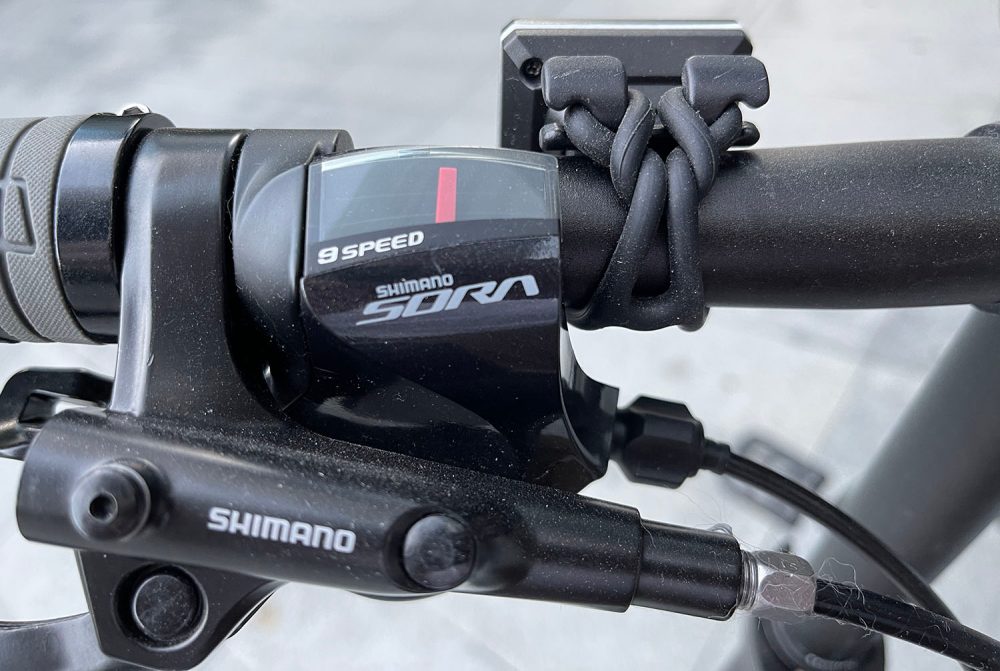
Specifications
The Furo X has some impressive specifications. There’s that carbon fiber frame, of course, but the components are equally pleasing.
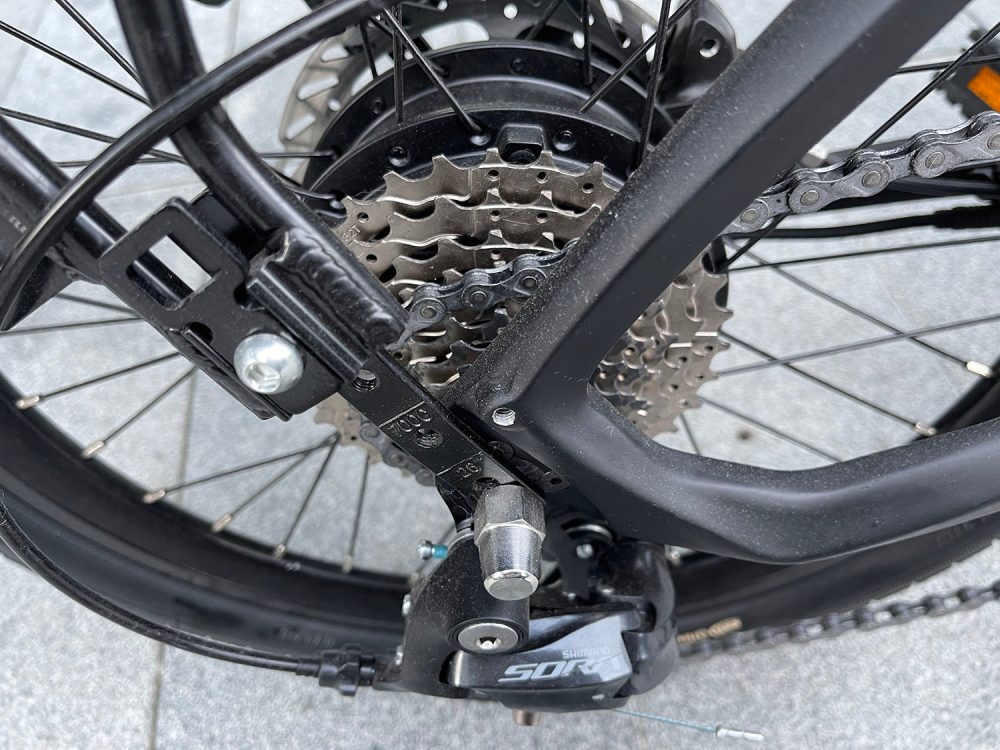
You get a 9-speed Shimano Sora indexed derailleur system and Shimano hydraulic disk brakes. This is a decent bike before you even get to the electrics.
The motor is a Bafang 250W rear hub motor coupled to the same Samsung Lithium-ion batteries used in the Tesla S.
Furo claims 28 miles from the standard 314Wh battery and 37 miles with the 378Wh Max model. To me, this again underlines the ‘city riding’ target market for this bike. Neither is a range suitable for a day ride, but even 28 miles is perfectly good enough for typical cycle commuting. Buy a second charger to keep at the office, and it would work even for long-distance cycle commuters.
At the time of writing, the price includes a ‘limited offer’ of free mudguards, rear luggage carrier, kickstand and ‘complete lighting kit’ (which I’ll moan about later).
The ride
The Furo X is an absolute joy to ride. Not many folding bikes deliver a rock-solid ride, but this one does.
One thing that helps enormously is the adjustability of the bike. Like any folding bike, you can adjust the saddle height – and using an oval-shaped seat-post means that it can’t rotate, which is a very nice design touch.
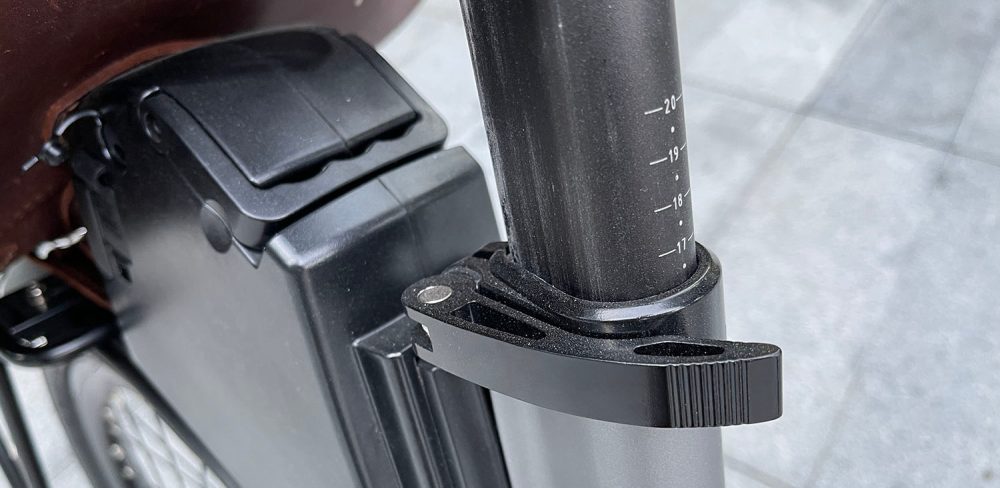
But the handlebar height is also adjustable, which I really appreciated. It means you can have a sporty position when you want to ride fast and a relaxed sit-up-and-beg position when you just want to meander along enjoying the sights.
There’s no suspension, but the combination of carbon frame and fat, low-pressure tires means that it’s comfortable to ride even over some of the many bumpy London streets.
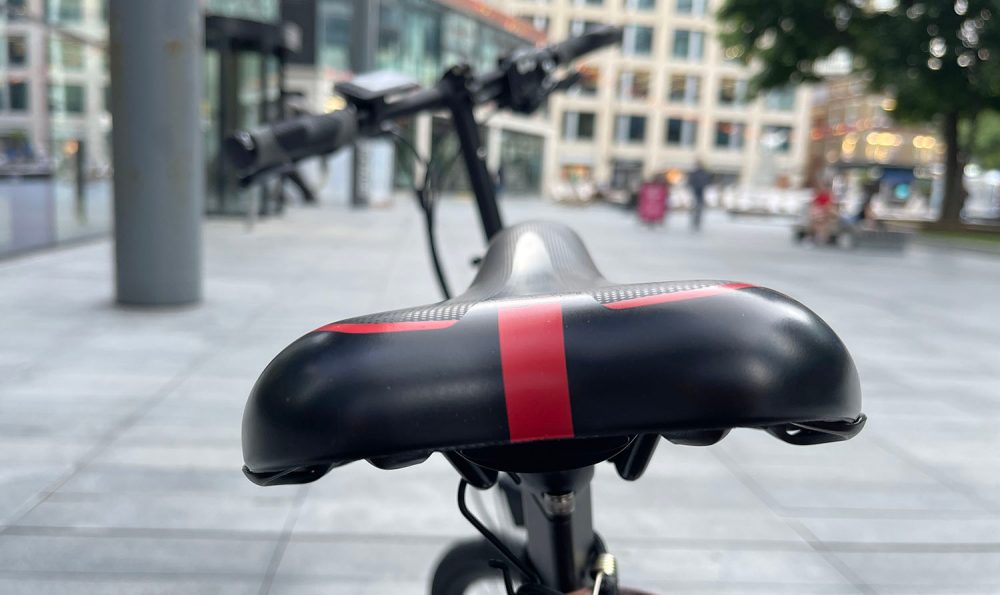
The saddle is a gel one. I’m a Brooks fan (the B17 specifically), and a saddle is usually the first thing I change when I buy a bike, but the stock saddle isn’t terrible. For the sorts of short rides for which the bike is designed, you could probably live with it.
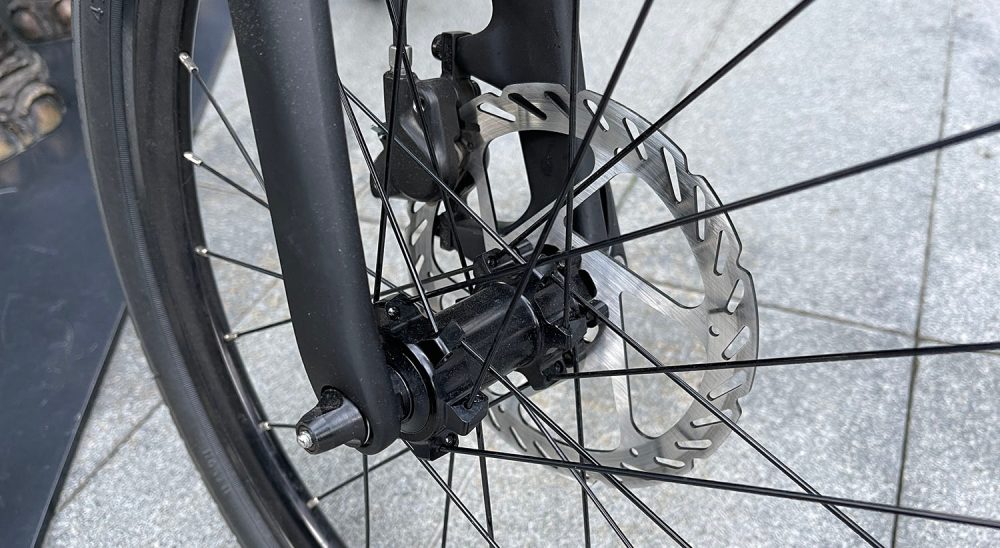
The brakes are awesome! They’re incredibly effective and very controllable once you get used to their power. I think I can stop faster on this than any bike I have ever ridden.
As a relatively short wheelbase bike with small wheels, the bike is quick-steering, but I’m used to that with my Brompton, and it’s something to which you quickly adjust. Once you have, then you appreciate the maneuverability in city traffic.
Without power assist, the Furo X is rather sluggish, but it is rideable. If you run out of power, then it wouldn’t leave you stranded – I would happily cycle a few miles home without the motor.
There’s a rear luggage carrier, and the addition of a cargo net and a couple of small bungies let me easily carry a backpack.
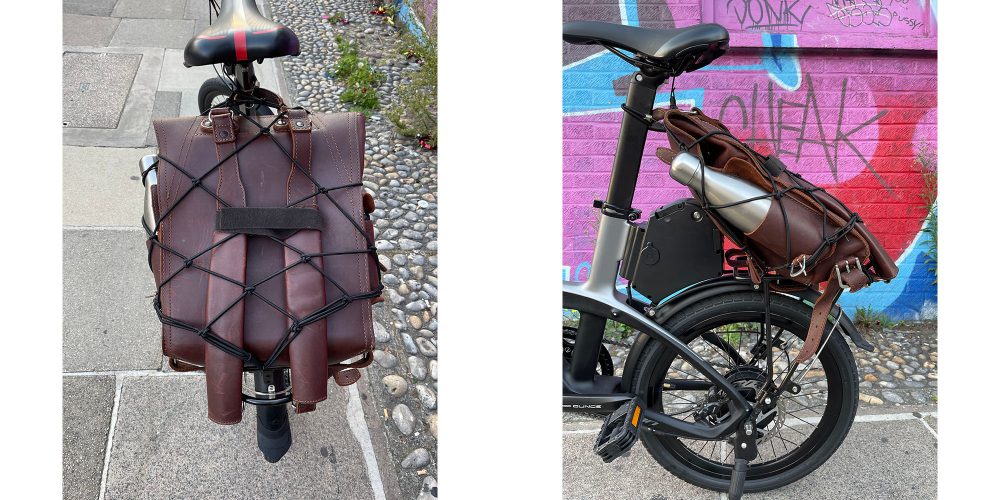
In short, I loved riding this bike.
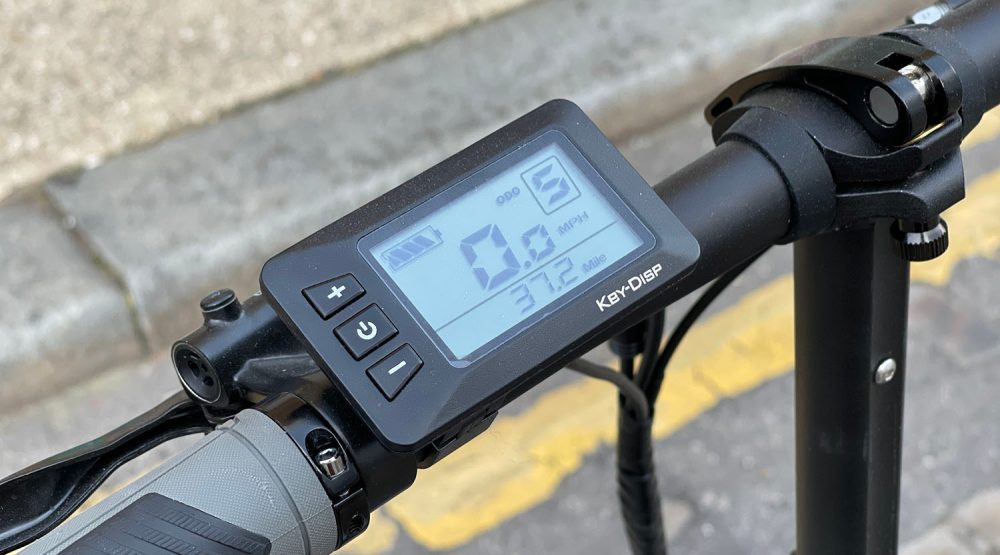
The motor
There’s a small control panel on the handlebars, with a power button plus + and – buttons. The main use for these is to adjust the power assistance level, but there are also various arcane button combinations to change settings – like from km to miles.
The display shows your speed, power assistance level, battery level (graphic only, no percentage or estimated range) and an adjustable function display offering odometer, trip meter, timer, watts, max speed or average speed. It does, however, lack the most useful display, which would be a clock.
There are five power levels. Level 1 essentially turns it into a conventional lightweight bike. It provides enough assistance to overcome the weight of the electrics but still feels like a very natural ride.
Level 5 is totally effortless up to about 16-17mph. With this level of assistance, I treated the bike as a 2-speed, setting off in 5th gear and quickly changing up to 9th. Even the steepest hill I could find in central London – Tower Hill – was no problem at all simply by dropping to 4th gear.
Pull away from a standstill in 4th gear in assist level 5, and you can literally pull a wheelie!
The maximum speed is tailored to the local law, so 20mph in the US. The assistance level does fall off noticeably once you hit about 17mph, but a 20mph cruise is certainly achievable with rather modest cycling effort.
The most natural way of matching the motor output to pedaling effort is a torque sensor, which is what high-end electric bikes use. The cheapest way is a speed sensor. The Furo X sits between the two, using a cadence sensor. This means the motor application is very perceptible but enables you to cruise along at 17-18mph with basically zero effort, simply rotating the pedals with as little effort as you would to cycle at 3mph in first gear.
There is a little lag, both when the motor cuts in and out. The lag when you start pedaling is barely perceptible. The delay in cutting out when you stop pedaling feels a little disconcerting, especially if you’ve gone straight from pedaling to braking – like when traffic signals change. For about half a second, you’re trying to stop the bike while the motor is trying to propel the bike. But that’s just psychological: It’s fast enough that any difference in stopping distance will be measured in inches.
The biggest issue I had with the motor was random cut-outs.
Random motor cut-outs
Well, I say random, but that isn’t quite the case. It happens (unpredictably) when you go over a bump. It happened to me several times in the few days I was testing the bike.
The first time it happened, I hit a small bump in the road – nothing dramatic, just the kind of surface imperfection you find everywhere on London streets – and the display switched off, and the motor died. This same thing happened two or three more times over the course of a week or so.
A variation I experienced once was that the display remained on, but the motor stopped working.
Most times, power-cycling the bike fixed it: Switching it off and on again. But when it happened without the display cutting out, power-cycling didn’t help. I then decided since it was caused by a bump, maybe it could be fixed by one. I bounced the bike on the rear wheel, and yep, that worked.
This is obviously annoying, but it could potentially be dangerous. When accelerating away from traffic signals, for example, you can be in front of traffic and accelerating nicely, but a motor cutout could see you cease accelerating or even decelerating unexpectedly.
Now, this might be a fault with this particular bike – it is a press loaner, so perhaps not always treated with the same loving care people give their own bikes. But I have a suspicion about what is happening. I think, because the battery is removable, it can be jolted and break the contact momentarily, so the bike thinks you’ve switched it off. If I’m right, then this is a drawback to the removable battery.
I did some Googling after encountering this problem and found that it’s not just me, and not just this particular bike.
I would imagine it wouldn’t be too difficult a fix for Furo Systems. It might be that better shock-absorbance would resolve it, which might be as simple as a piece of rubber. Alternatively, it might mean adjusting the connector so that a slight movement doesn’t disconnect power. But it is a fix that needs to be made.
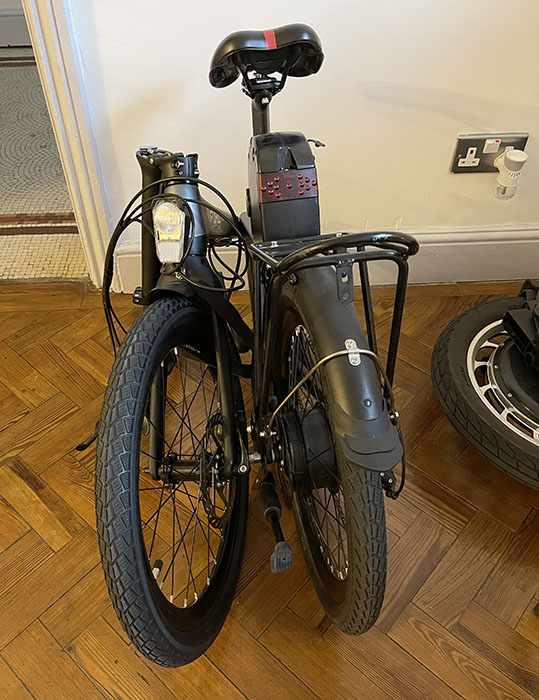
The fold – carrying and storing the bike
The bike is light by electric bike standards. I mean, I wouldn’t want to carry it very far, but for multi-modal transport, where you perhaps take a train for part of the journey and cycle at either end, there’s not generally much carrying involved. I think I’ve taken my Brompton on every form of public transit – trains, planes, buses, ferries, you name it. I generally wheel it to the door, fold it and then just carry it to my seat, and you could, in principle, do the same with this – so the weight isn’t an issue.
The actual fold and unfold works well and includes folding pedals on both sides, but the final folded result is far from ideal.
Although Furo has copied the overall mechanics of the Brompton fold, the bike doesn’t clip together in any way. You have to use a (supplied) velcro strip to hold it together, which is inelegant and doesn’t provide confidence that it will remain folded.
More than this, the width and shape of the folded bike are just incredibly awkward to carry. I couldn’t find any comfortable way to do it. And while the Brompton fits neatly between back-to-back train seats or into an overhead locker on long-haul aircraft, the X is far bigger when folded and gets in the way much more on public transit.
There is a mode where you can wheel it on one wheel semi-folded, but that’s no good for stairs or escalators and makes the bike too big for crowded platforms on public transit.
So right away, I would say if multi-modal transport is your vision for this bike, then this is probably not the ideal solution, unless the two forms of transport are car and bike, and you have enough trunk space.
However, if all you want is to fold the bike at either end of your journey, no problem. I mean, it’s not as compact as a Brompton, as you can see below, but most people are going to find somewhere to put it, even in a small city center apartment.
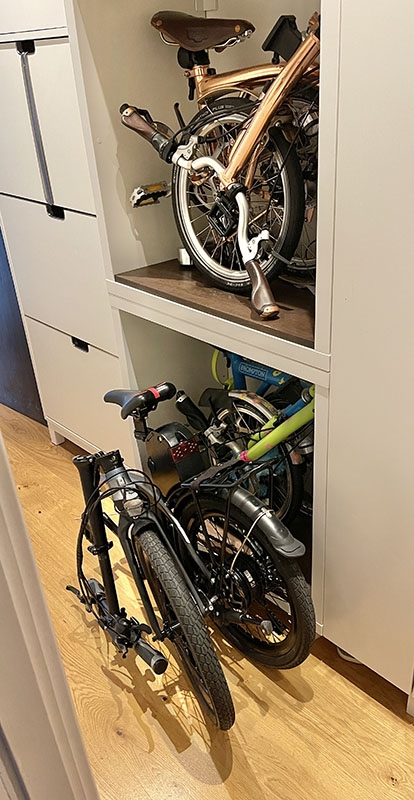
Charging
Charging is very easy with the supplied brick: Just open the rubber flap and plug it in.
If you can’t easily store the bike close to a plug socket, then using a key lets you easily remove the battery and charge it wherever is convenient.
As I mentioned in the opening, the removable battery isn’t pretty, but it is convenient. However, it’s also top of my suspect list for the motor cut-outs.
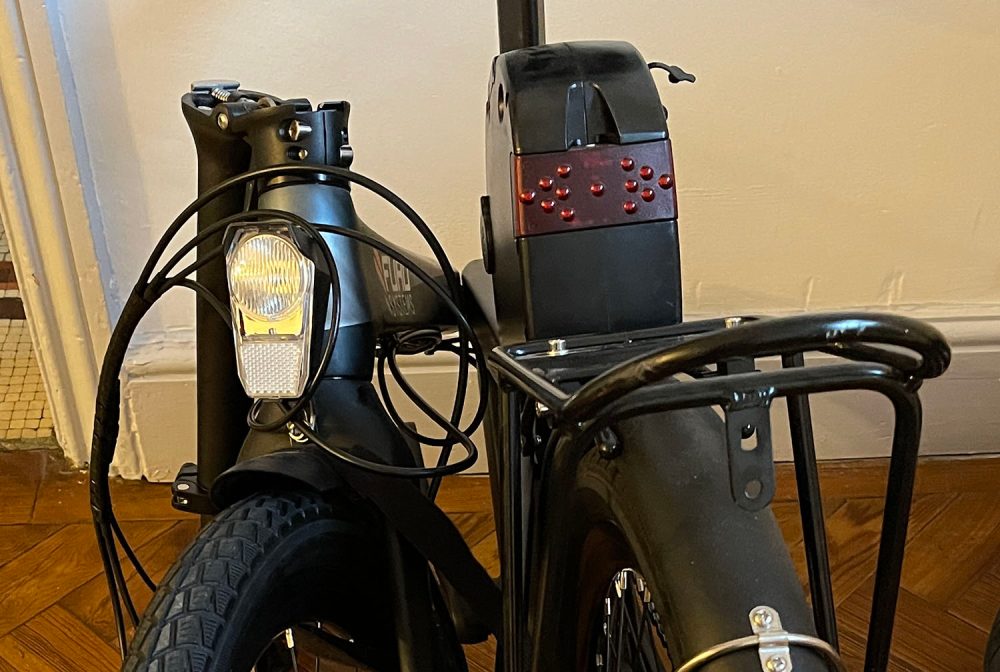
Lights
The lights are the worst feature of the bike, by far!
First, the front light is only kind of vaguely adequate, while the rear light is just a joke. It is literally a single LED! You could use the hazard lights, which I’ll get to in a moment, but it’s still not even close to bright enough for road use.
Worse, the front light doesn’t draw power from the main battery! It’s a standalone light, which is ridiculous on an electric bike.
But the worst thing is that silly rear light is positioned in front of the rack, not at the back of it, so as soon as you put a bag on the rack, it is completely hidden.
The bike is fitted with indicators, controlled by a remote on the handlebars. Like all bike indicators, these are not just a pointless gimmick but actively dangerous. The left and right indicators are so close it’s basically impossible for a driver to see whether you are indicating left or right, despite the attempt at an arrow. This is dangerous because an inexperienced cyclist may not know this, so may use them instead of arm signals.
The only semi-useful thing about them is you can press both buttons simultaneously to make both lights flash, which means the rear light goes from about 2% of the light needed to about 10%.
Finally, there’s a USB port to charge your phone. This would be handy if it were on the handlebars, but it’s not – it’s back in the battery unit, so effectively inaccessible.
Furo X: Pricing and conclusions
The Furo X costs $2299.
That’s a reasonably serious chunk of change, but it’s actually relatively cheap in the folding electric bike segment. The electric Brompton, for example, starts at $3,800. The Hummingbird is $5,200. The Vektron S10 costs $4,000.
When you consider the competition, the ride quality, and the components you’re getting, I think the Furo X is a really good value.
If you’re looking for a folding electric bike you’re never going to have to carry, then I think this is a serious contender.
However, if you need a bike that lets you hop and off trains or metro services, I honestly wouldn’t consider it. It’s really not comfortable to carry any distance at all. This is a bike for unfolding, riding to your destination, folding and storing. Alternatively, pulling out of the trunk of your car and riding the remaining distance.
Either way, the motor cutout issue is something of a concern, so I would also wait for the company to announce a fix for that; otherwise, you might just need that two-year warranty.
All the same, I’ve enjoyed riding it tremendously and will be sad to see it go.
The Furo X is available from the company’s website for @2,299, with free shipping.
Subscribe to Electrek on YouTube for exclusive videos and subscribe to the podcast.
Author: Ben Lovejoy
Source: Electrek



